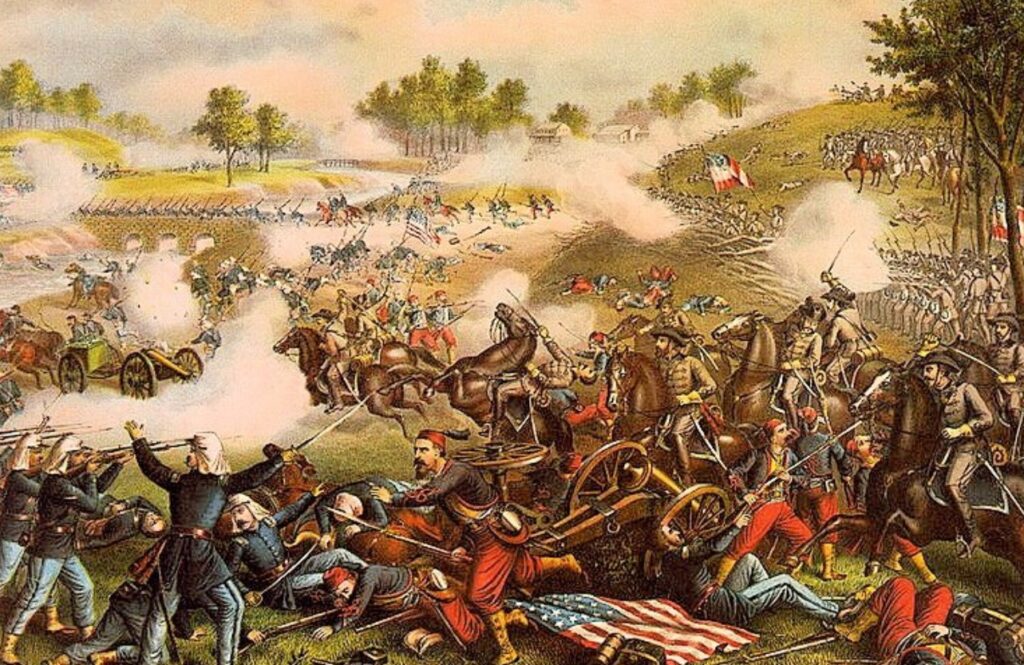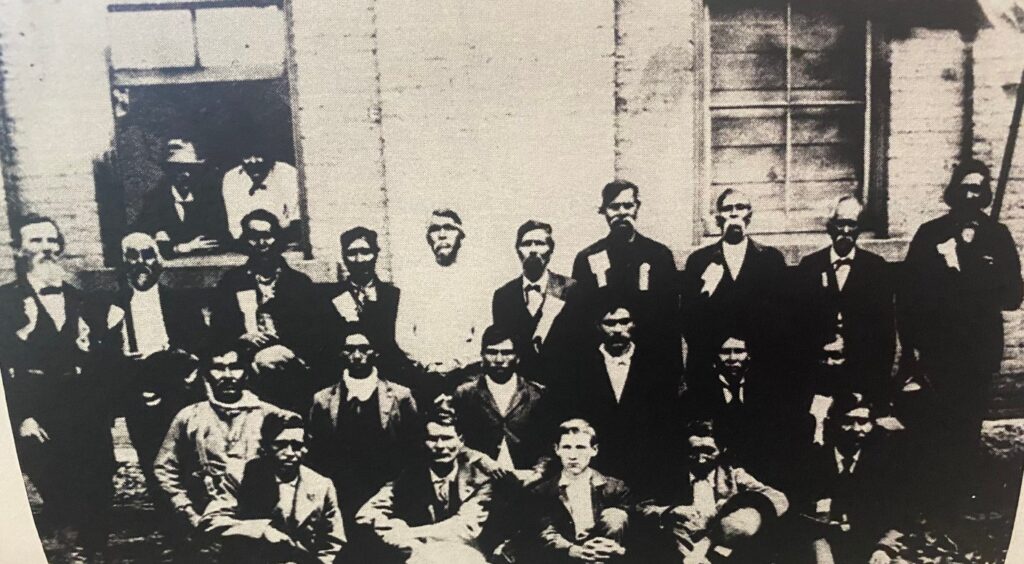Salisbury
Pick up a free taped guided tour and other information at the visitor center, 204 Innes St. For Salisbury and Rowan County information, call 800-332-2343.
Confederate States Military Prison Site and Salisbury National Cemetery
202 Government Road, Salisbury NC 28144
Civil War Trails sign 224 E Bank St, Salisbury
704-636-2661 (cemetery)
The Confederate government in 1861 purchased 16 acres here, including several buildings, to serve as a prison for captured Union troops. When the exchange system broke down in 1864, the facility became overloaded to four times its original capacity of 2,500 men. An estimated 3,500 prisoners died here. The Salisbury National Cemetery was established orginally by the Confederates as the prison burial ground. Several monuments honor the dead. A small museum with information about the prison and cemetery is located in the office open Monday–Friday 8 am–4:30 pm.

The Dr. Josephus W. Hall House
226 S Jackson St, Salisbury NC 28144
704-636-0103
Dr. Hall served as surgeon for the Confederate States Military Prison nearby and served at several other hospitals for wounded Confederates until the end of the war. This 1820 house is open to the public weekend afternoons 1-4 pm. Civil War Trails sign on site. $3.
High Point
Mendenhall Plantation
603 W Main St, Jamestown NC 27282
336-454-3819
Home of Quaker Richard Mendenhall, an active abolitionist. Featured at the site is a false-bottomed wagon used to transport slaves to freedom. Open Tuesday–Friday 11 am–2 pm, Saturday 1–4 pm and Sunday 2–4 pm.
Winston-Salem
Emancipation in Salem
Trails sign at the Old Salem Museum, 600 S Main St, Winston-Salem NC 27101
Union cavalry entered Salem May 14, 1865, weeks after the Confederate surrender at Durham. The chaplain of the occupying troops read an order at this church proclaiming the end of slavery, which was cause for much celebration here.
Yadkin County
(west of Winston-Salem)
Yadkinville
Trails sign one block east of Route 601 on Hemlock Street
Divided loyalties in the town and area erupted into violence in a February 1863 shootout and again in July 1864 when Unionists freed several prisoners and raided home-guard weapons and ammunition. Approximately 1,200 men served in the Confederate army, but more than a few enlisted in Union units.

Bond School House
Trails sign 1140 Deep Creek Church Road, 4 miles northeast of Yadkinville
A shootout here Feb. 12, 1863, erupted when Confederate militia swept down on a small gathering of anti-war Quakers and a Confederate deserter. Several on each side were killed.
Richmond Hill
4641 Law School Road, East Bend NC 27018
Richmond Hill was the home of North Carolina Supreme Court Chief Justice Richmond Mumford Pearson. He opposed secession and worked to free North Carolinians imprisoned for avoiding the draft. A 30-acre park surrounds the home. Living history open houses are offered the third Sunday of each month May-October, 2-4 pm. Trails sign in Richmond Hill Park at the end of Law School Road, north of Route 67 between Boonville and East Bend.
Boone
Camp Mast
Trails sign at 815 W King St, Boone NC 28607
This Confederate home guard camp, created to protect the community and round up Unionists, bushwhackers and deserters, was attacked in February 1865 by more than 100 men from Banner Elk. The besieged camp commander called for a vote and only 11 members voted to fight it out. Following the surrender, those who had voted to fight were sent to a Federal prison in Ohio.

Avery County
Blalock Family
Trails sign located at the Cannon Memorial Hospital, 436 Hospital Drive, Newland NC 28604
Avowed Unionists Sarah and Keith Blalock both were forced to serve briefly in the Confederate army (hoping to desert to Union lines). Later, driven from their home by Confederate conscription officers, the couple fled to the mountains; and Keith joined the Union army as a scout, participated in several skirmishes and was wounded. He guided escaped Union prisoners and dissidents to safety in Banner Elk.

Cranberry Iron Mine
Trails sign at the Old Cranberry High School, 5215 Elk Park Highway, Elk Park NC 28622
This was the site of one of the many rural iron mines prized by Confederates to supply raw materials for war production. Dozens of men worked here during the war producing bar iron for Southern foundries.
Banner Elk
Trails sign located at the Banner Elk Museum, 7990 Hickory Nut Gap Road, Banner Elk NC 28604
Named for the local Banner family, this small community provided a system of safe houses for escaped Union prisoners and refugees from Confederate conscription. The Banners were active, providing food and shelter for the escapees while they waited for guides to lead them to safety in Tennessee.
Transylvania County (south of Asheville)
Alison-Deavor House
Trails sign located at 200 Asheville Highway, ZIP 28768 (3 miles north of Brevard)
This was the scene of a dramatic shooting incident sparked by the turmoil here in February 1865. Most of the area men joined the Confederate army, but late in the war Union partisans and Confederate deserters roamed the territory. A gang of these “bushwackers” approached the home of Confederate Capt. James Deaver and killed his father.

Thomasville
Thomasville (A Key Stop and Refuge)
Trails sign at the visitor center, East Main and Trade streets
A key stop on the North Carolina Railroad, this town (war-time population about 300) was an important refuge for sick and wounded Confederate soldiers outside the war-torn eastern sections of the state. Wounded Union soldiers joined them late in the war.
Thomasville City Cemetery
Trails sign in the cemetery on Memorial Park Drive
Confederate and Union soldiers, many of whom died in the teeming hospitals of the city, are buried here.
Hospitals, Caring for the Sick and Wounded
Trails sign at intersection of East Main and Memorial Park Drive, one block south of Main and Salem streets
Removed somewhat from the main battlefields in the East, this small town became a hospital center for both wounded Confederate soldiers and sick civilians. In March 1865, hundreds of wounded made their way here as Sherman invaded the state.
Wilkesboro
Fort Hamby
Trails sign located in the Fort Hamby Park at the West Kerr Scott Reservoir, 1534 S Recreation Road, Wilkesboro NC 28697
Union and Confederate deserters occupied this “fort,” actually a two-story log house, at the end of the war. The outlaw group led a reign of terror in the neighborhood until local law enforcement caught up in May 1865.
Burnsville
Burnsville
Trails sign at the Burnsville Visitor Center, adjacent to the John McElroy House Museum, 106 W Main St, Burnsville
Divided loyalties here led to much civil and personal strife as Confederate authorities attempted to retain control over a strong Unionist population. Men from the area served in both armies, and later the town became a haven for deserters.

Franklin
Thomas’s Legion
Trails sign at the Macon County Historical Museum,
36 W Main St, Franklin NC 28734
Confederate Col. William H. Thomas organized Thomas’s Legion of Cherokee Indians and mountaineers here in September 1862. Several locals, both white and Indian, joined the unit, which fought in Tennessee, Kentucky, Virginia and North Carolina. Thomas eventually recruited more than 2,000 men, among them about 400 Cherokee.
Dixie Hall
Trails sign located across the street from the above site at the Macon County Courthouse
One of the last formal surrenders of Confederate forces happened here, the site of Dixie Hall, on May 12, 1865. Military clashes involving Thomas’s Rangers continued locally until then.
Cashiers
Zachary-Tolbert House
Trails sign located at the house on Route 107, 2 miles south of Cashiers
The owner of this house, Mordecai Zachary, had strong Confederate ties, serving in Thomas’s Legion. His brother and neighbor, Alexander, felt differently, helping escaped Union prisoners. Alexander’s sons served on both sides.

Madison County
Mars Hill College
Trails sign located in the center of the Mars Hill College campus on College Street
This small institution found itself in the middle of some nasty business as local folks divided between North and South. A small Confederate detachment held the strategic crossroads town early, but lost support as Union sympathies grew. When local Union troops entered town at the end of the war, they burned several of the college buildings.
Marshall
Trails sign located in front of the Col. Allen House on Main Street, Route 25-70, in Marshall –
Divided loyalties boiled over early here when a local election in May 1861 resulted in gunfire and death. In January 1863 a band of Union soldiers and citizen sympathizers from the Shelton Laurel community raided Marshall, burning and looting buildings. Confederate troops executing 13 prisoners. The event became known as the “Shelton Laurel Massacre”.
Warm Springs Hotel
Trails sign located at the Hot Springs Resort off Route 25-70
A Union regiment made up largely of Confederate deserters and Union-supporting area citizens captured and briefly held this place in the fall of 1863. The hotel was Union headquarters until the Northerners were expelled in late October.
Asheville and Area
Zebulon B. Vance Birthplace State Historic Site
911 Reems Creek Road, Weaverville NC 28787
704-645-6706
Zeb Vance was a prominent North Carolina figure before, during and after the war. He served as governor 1862-1865. Reconstructed 1830 log buildings commemorate the site of Vance’s birth. Exhibits cover his career, including the Civil War, and that of his brother, Confederate Gen. Robert B. Vance.

Battle of Asheville
Kirby’s Expedition, Trails sign on Campus Drive, UNC-Asheville, Asheville NC 28801
About 900 Union soldiers under Col. Isaac Kirby entered town April 6, 1865. Opposing them were about 300 Confederates (including home guard and convalescing soldiers) under Col. George Clayton entrenched near here. Clayton’s men opened fire on the approaching Federals and, after several hours, forced a Federal retreat.
Battery Porter, Trails sign at the Grove Arcade, 1 Page Ave, Asheville NC 28801
During the April 6 battle Confederate Battery Porter was posted here. Following the fight the guns and men of the unit withdrew and were captured near Hendersonville. Black Union soldiers later drove the captured artillery pieces through Asheville.
1st U.S. Colored Heavy Artillery
Trails sign at 6 Chestnut St, Asheville NC 28801
Gen. David Tillson organized this unit of Union black troops in 1864 and camped nearby when assigned to Asheville. The artillerists served with Gen. George Stoneman in this area and also in operations in Tennessee and Alabama.
Camp Clingman
Trails sign in Aston Park, Hilliard Avenue, Asheville NC 28801
Pro-slavery, pro-secession North Carolina politician Thomas Clingman, who was serving in the U.S. Senate at the outbreak of the war, lived here. He later became a Confederate general and was wounded at Petersburg in 1864. Confederate troops camped here early in the war and returning soldiers used the place as a tournament grounds.
Note: Sign temporarily removed April 2016.
George Avery
Trails sign at the South Asheville Cemetery, 20 Dalton St, Asheville NC 28803
Avery, a slave blacksmith, joined the United States Colored Troops in Greeneville, Tenn., in 1865. He was probably among a group of slaves freed by Union. Gen. George Stoneman. Avery’s unit guarded railroads in Tennessee the rest of the war. Returning to Asheville, his former owners provided him with land, materials to build a home and a job as caretaker of this cemetery. He was 96 years old when he died.
Wartime Jail: Asheville’s Prisons
Trails sign at the Asheville visitor center, 36 Montford Ave, Asheville NC 28801
Overflowing prisons housing Confederate draft evaders and deserters, runaway slaves and Union prisoners, were located in various parts of the city. The school here, the former Asheville Military Academy, was one of the buildings used for that purpose. Among Asheville’s prisoners were Unionist newspaper editor Alexander Jones and Col. James Keith who led the infamous Shelton Laurel Massacre of Unionist citizens in Madison County.
Landsman Riley Powers
Trails sign at South Buncombe Library, 260 Overlook Road, Asheville NC 22803
In February 1862 Confederate Pvt. Powers was ordered to join the crew of the former USS Merrimack at Hampton Roads, Va. He was one of many soldiers with no naval experience to train on the new ironclad created from the Merrimack, the CSS Virginia. He served onboard during the famous “Battle of the Ironclads” in Hampton Roads March 7-8, 1862.
Asheville’s Enslaved People
Trails sign at the Asheville Public Works building, 161 S Charlotte St, Asheville NC 28801
At the beginning of the war, slaves made up more than 15 percent of the county’s population. They worked as waiters, maids, grooms, cooks and trail guides at the Eagle Hotel here. The slave population doubled as refugees came to the city to protect their “property” from Union advances into the state. Some slaves here helped Union refugees and some fled into Tennessee. Union Gen. George Stoneman freed the city’s slaves when he came through in April 1865.
Riverside Cemetery
Trails sign in the Riverside Cemetery, 53 Birch St, Asheville NC 28801
Wartime governor Zebulon Vance and his brother, Robert, are buried here with more than 250 Confederate veterans. Also here are Confederate Gens. Thomas Clingman and James Martin joining Union Col. Andrew McGonnigle, who won the Medal of Honor at Cedar Creek, Va., and Capt. James Posey who was one of Abraham Lincoln’s bodyguards.
Smith-McDowell House
Trails sign at 283 Victoria Road, Asheville NC
This was the home of William W. McDowell, who helped raise several Confederate units and served as an officer in one of the war’s first major land engagements at Big Bethel, Va. After returning home in 1864, McDowell served as a Confederate treasury officer, selling government bonds. In April 1865, he encouraged one of his slaves to join the United States Colored Troops.
Waynesville and Haywood County
(west of Asheville)
Waynesville Engagement
Trails sign located in Sulpher Springs Park off Timothy Lane, Waynesville NC 28786
Some of the last fighting of the war occurred here after Union soldiers occupied Waynesville in early May 1865. Members of Thomas’s Legion attacked May 6 routing about 200 Federals near here. The Union troops retired to Waynesville and were surrounded. At a meeting the next day, the Confederates learned that the Civil War was over and surrendered.

“Thomas’s Last Resting Place”
Trails sign located in Greenhill Cemetery, Hillview Circle and Main Street in Waynesville
Col. William Thomas, the only white man to serve as a Cherokee chief and an influential figure in western North Carolina prior to the war, is buried here. Thomas organized his Legion, composed of Cherokee Indians and mountain people in September 1862. The Legion fought in Tennessee, Virginia and Kentucky and largely prevented an early Union occupation of western North Carolina.
“Battle House”
Trails sign located at 16 S Main St, Waynesville NC 28786
The Battle House stood near this site until is was demolished in 1899. By the evening of May 6, 1865, Union forces in Waynesville were surrounded by more than 600 Confederates, part of them Thomas’s Legion. The Union commander sent a note requesting a meeting in the house to discuss his surrender. At the meeting, learning the war was over and the major Southern armies had surrendered, the Confederates surrendered instead.
Locust Field Cemetery
Trails sign located at Locust Street and Pennsylvania Avenue, across from the library in Canton
(library)
The Locust Field Church served as a Confederate campground and rallying point throughout the war. After losing control of the Cumberland Gap in 1863, many Confederates retreated to the area and camped in the churchyard. Six companies of Thomas’s Legion camped here the last winter of the war.
“Kirk’s Raid”
Trails sign located in the Ghost Town amusement park, 16 Fie Top Road, Maggie Valley NC 28751
Union raiders under Col. George Kirk passed through this area on Feb. 1, 1865, killing several citizens and burning buildings on their way to Waynesville. Kirk arrived in Waynesville Feb. 4 and sacked the town. After leaving, the Federals encountered resistance but escaped back into Tennessee.
Robbinsville
“Civil War in Graham County”
Trails sign located at the Graham County Courthouse, 129 S Main St, Robbinsville NC 28771
Divided loyalties plagued this area throughout the war as citizens on both sides suffered from both Union and Confederate raiders, bushwhackers and other renegades. One of the last surrenders east of the Mississippi occurred here May 14, 1865, when part of the famed Thomas’s Legion was issued parole papers.

Lincoln County, northwest of Charlotte
Cottage Home, Trails sign located 3 miles south of Route 73 at the entrance to the Lincoln CT Power Plant – This was the site of the home of the Rev. Robert Hall Morrison family. Three of Morrison’s daughters married men who became Confederate generals: Rufus Clay Barringer, Daniel Harvey Hill and Thomas J. “Stonewall” Jackson.
After Jackson’s death, his widow, Mary Anna, and young daughter Julia came back to Cottage Home. The house burned in 1911.

